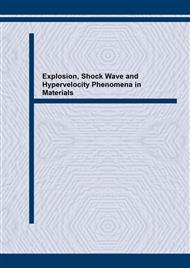[1]
K. Hokamoto, M. Fujita, H. Shimokawa and H. Okugawa: J. Mater. Process. Technol. Vol. 85 (1999), p.175.
Google Scholar
[2]
K. Hokamoto, Y. Ujimoto and M. Fujita: Mater. Sci. Forum Vols. 426-432 (2003), p.4039.
Google Scholar
[3]
K. Hokamoto, Y. Ujimoto, S. Tanaka and M. Fujita: Mater. Sci. Forum Vols. 437-438 (2003), p.261.
Google Scholar
[4]
B. Crossland: Explosive Welding of Metals and Its Application (Oxford University Press, 1981).
Google Scholar
[5]
E.L. Lee, M. Finger and W. Collins: JWL Equation of State Coefficients for High Explosives, Lawrence Livermore Laboratory, UCID-16189 (1973).
DOI: 10.2172/4479737
Google Scholar
[6]
S.P. Marsh: LASL Shock Hugoniot Data (University of California Press, 1980).
Google Scholar
[7]
H. Iyama, A. Kira, S. Kubota, K. Hokamoto, and S. Itoh: Proc. of ASME Pressure Vessels and Piping Conference, Vol. 414-2 (2000), pp.159-164.
Google Scholar
[8]
K. Katayama, S. Kibe, and T. Yamamoto: Numerical and Experimental Study on the Shaped Charge for Space Debris Assessment, Acta Astronautica Vol. 48, No. 5-12 (2001), pp.363-372.
DOI: 10.1016/s0094-5765(01)00073-x
Google Scholar
[9]
K. Hokamoto, T. Izuma and M. Fujita: Matell. Trans. Vol. 24A (1993), p.2289.
Google Scholar


